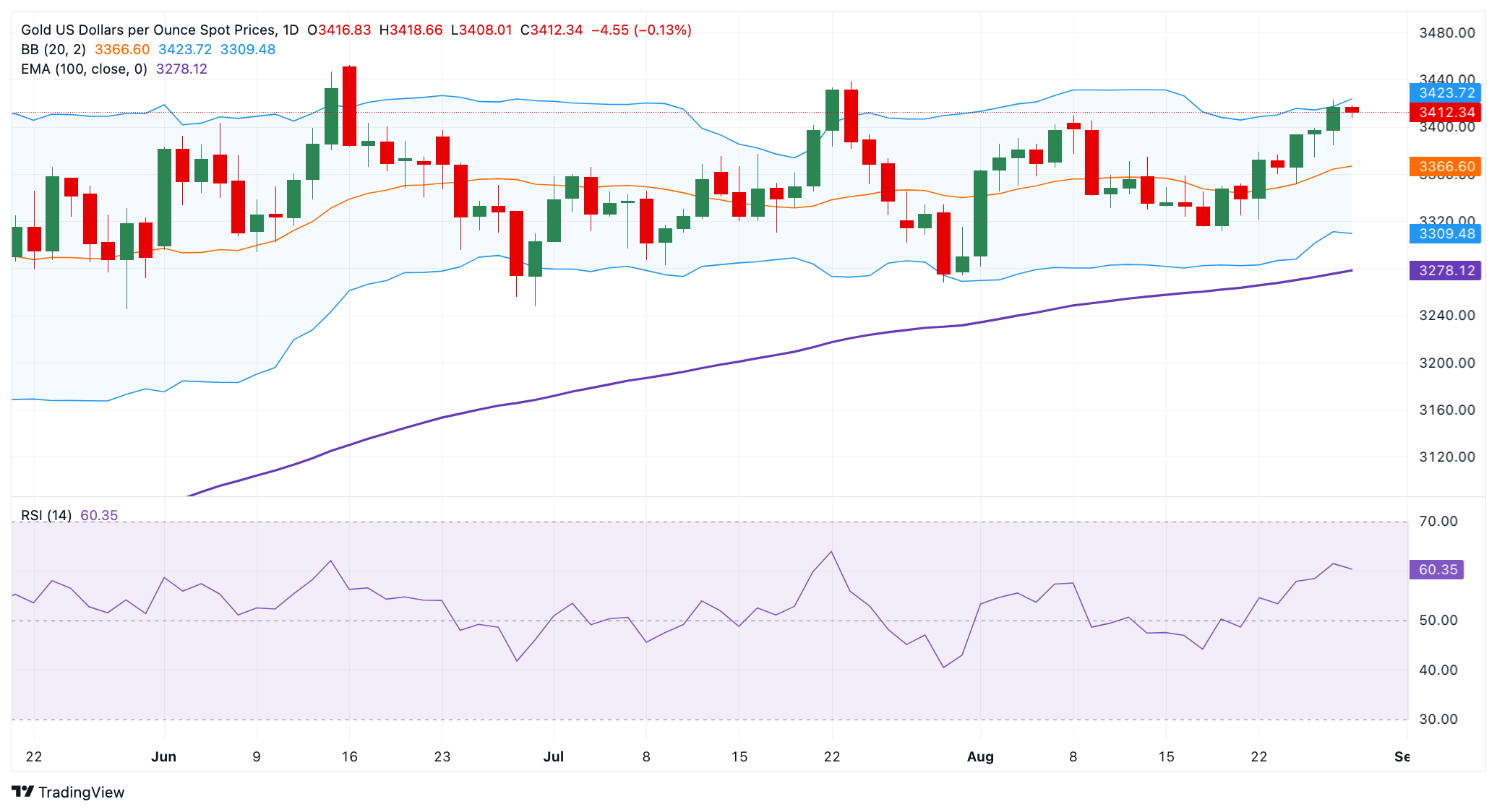- Gold price declines in Friday’s early European session.
- Profit-taking and a firmer US Dollar undermine the Gold price, but rising Fed rate cut expectations might limit its losses.
- Traders will closely monitor the US July PCE inflation report later on Friday.
The Gold price (XAU/USD) edges lower during the early European trading hours on Friday. The yellow metal retreats from near a five-week high of $3425 in the previous session amid some profit-taking. Additionally, the upbeat US economic data, including the US Gross Domestic Product (GDP) and weekly Initial Jobless Claims data, provide some support to the US Dollar (USD) and weigh on the USD-denominated commodity price.
Nonetheless, rising bets that the US Federal Reserve (Fed) will cut interest rates in the September meeting and dovish remarks from New York Fed chief John Williams might underpin the precious metal. Lower interest rates could reduce the opportunity cost of holding Gold.
The release of the US Personal Consumption Expenditures (PCE) Price Index report for July will take center stage later on Friday. The headline PCE is projected to show an increase of 2.6% YoY in July, while the core PCE is estimated to show a rise of 2.9% during the same period.
Daily Digest Market Movers: Gold drifts lower ahead of key US PCE inflation data
- “The precious metal remains a popular pick with investors ahead of what is expected to be a period of looser monetary policy in the U.S. starting next month,” said KCM Trade chief market analyst, Tim Waterer.
- Fed Governor Christopher Waller said on Thursday that he would support an interest-rate cut in the September meeting and further reductions over the next three to six months to prevent the labor market from collapsing, per Reuters.
- The US GDP grew at an annual rate of 3.3% in Q2, compared to the initial estimate of 3.0%, the US Bureau of Economic Analysis (BEA) showed Thursday. This figure came in better than the estimation of 3.1%.
- The US Initial Jobless Claims for the week ending August 23 declined to 229K versus 234K prior (revised from 235K). This reading came in below the market consensus of 230K.
- New York Fed President John Williams said on Wednesday that it is likely interest rates can fall at some point, but policymakers will need to see what upcoming data indicate about the economy to decide if it is appropriate to make a cut next month.
- Traders are currently pricing in nearly an 85% possibility of a quarter-point Fed rate cut next month, according to the CME FedWatch tool.
Gold’s constructive outlook prevails above the 100-day EMA.
The Gold price trades in negative territory on the day. The bullish tone of the precious metal remains intact in the longer term, with the price holding above the key 100-day Exponential Moving Average (EMA) on the daily chart. The upward momentum is supported by the 14-day Relative Strength Index (RSI), which stands above the midline near 60.50. This displays the bullish momentum in the near term.
The upper boundary of the Bollinger Band of $3,425 acts as an immediate resistance level for XAU/USD. Sustained trading above this level could take the yellow metal to $3,439, the high of July 23. The next upside target to watch is $3,500, the psychological level and the high of April 22.
On the downside, the initial support level for Gold is seen at $3,373, the low of August 27. Red candlesticks closing below the mentioned level could expose $3,351, the low of August 26. The additional downside filter is located at $3,310, the lower limit of the Bollinger Band.

Inflation FAQs
Inflation measures the rise in the price of a representative basket of goods and services. Headline inflation is usually expressed as a percentage change on a month-on-month (MoM) and year-on-year (YoY) basis. Core inflation excludes more volatile elements such as food and fuel which can fluctuate because of geopolitical and seasonal factors. Core inflation is the figure economists focus on and is the level targeted by central banks, which are mandated to keep inflation at a manageable level, usually around 2%.
The Consumer Price Index (CPI) measures the change in prices of a basket of goods and services over a period of time. It is usually expressed as a percentage change on a month-on-month (MoM) and year-on-year (YoY) basis. Core CPI is the figure targeted by central banks as it excludes volatile food and fuel inputs. When Core CPI rises above 2% it usually results in higher interest rates and vice versa when it falls below 2%. Since higher interest rates are positive for a currency, higher inflation usually results in a stronger currency. The opposite is true when inflation falls.
Although it may seem counter-intuitive, high inflation in a country pushes up the value of its currency and vice versa for lower inflation. This is because the central bank will normally raise interest rates to combat the higher inflation, which attract more global capital inflows from investors looking for a lucrative place to park their money.
Formerly, Gold was the asset investors turned to in times of high inflation because it preserved its value, and whilst investors will often still buy Gold for its safe-haven properties in times of extreme market turmoil, this is not the case most of the time. This is because when inflation is high, central banks will put up interest rates to combat it.
Higher interest rates are negative for Gold because they increase the opportunity-cost of holding Gold vis-a-vis an interest-bearing asset or placing the money in a cash deposit account. On the flipside, lower inflation tends to be positive for Gold as it brings interest rates down, making the bright metal a more viable investment alternative.







